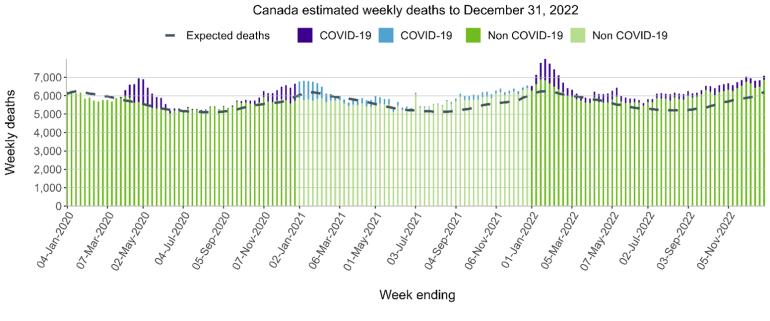Question:
How did Canadian excess deaths progress in 2022?
Answer:
Canadian excess deaths (based on pre-pandemic expectations) have increased considerably since the beginning of 2022. While they were at 5.7% in 2020, 7.5% in 2021, excess deaths reached 13.5% in 2022; a far larger number than in the US (≈10% in 2022) and in England (≈6% in 2022)*. While the number of COVID deaths increased, so did the number of non-COVID related deaths.
The chart below shows the estimated weekly deaths between 2020 and 2022 in Canada. The dotted line depicts the deaths in those weeks that were expected before the pandemic, calculated and published by Statistics Canada based on 2016-2019 data. Excess deaths are all deaths above the expected deaths dotted line in the chart. As depicted in the chart, excess deaths peaked at the beginning of 2022, briefly decreased in February-March 2022 and increased to persistently elevated levels for the remainder of the year.

Sources: Statistics Canada (Table 13-10-0792-01) and Government of Canada (COVID-19 daily epidemiology update).
Key takeaways
- Excess deaths significantly increased since the beginning of 2022.
- The last major wave of the COVID-19 pandemic was the Omicron wave that occurred in January-February 2022. Since then, excess deaths remained persistently high (after a brief dip in February-March).
- The figures presented are for the general Canadian population. There are significant regional variations in excess death levels, with western Canada (BC, AB, SK) experiencing the highest levels of excess deaths (16-20% more deaths than expected).
- While COVID-19 is still an important driver, cause of death data suggests that other factors are contributing to excess mortality in Canada.
The key questions are:
- What are the underlying causes of the excess mortality observed in 2022? Are they indirect effects of the pandemic, mis-coded COVID deaths or entirely attributable to something else? Do they affect all age groups or only certain age groups? And will this trend persist into 2023 and beyond (if so, for how long)?
- What will this mean for DB pension plans trying to understand the “new normal” for mortality rates in the aftermath of the COVID-19 pandemic?
- How should we allow for this emerging picture when modeling future mortality assumptions?
What do you think?
If you are interested in exploring more about the excess deaths in Canada in 2022, what could have caused them and whether they are expected to continue, check out our webinar on the subject.
*Note, at time of writing we did not have data for the whole of the UK. Throughout the pandemic, excess mortality has generally been lower in Scotland, Wales and Northern Ireland than in England, so it is likely that the overall excess for the UK would be slightly lower than that for England.”




